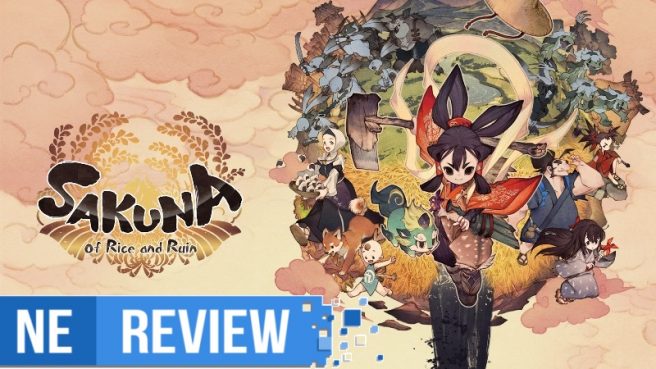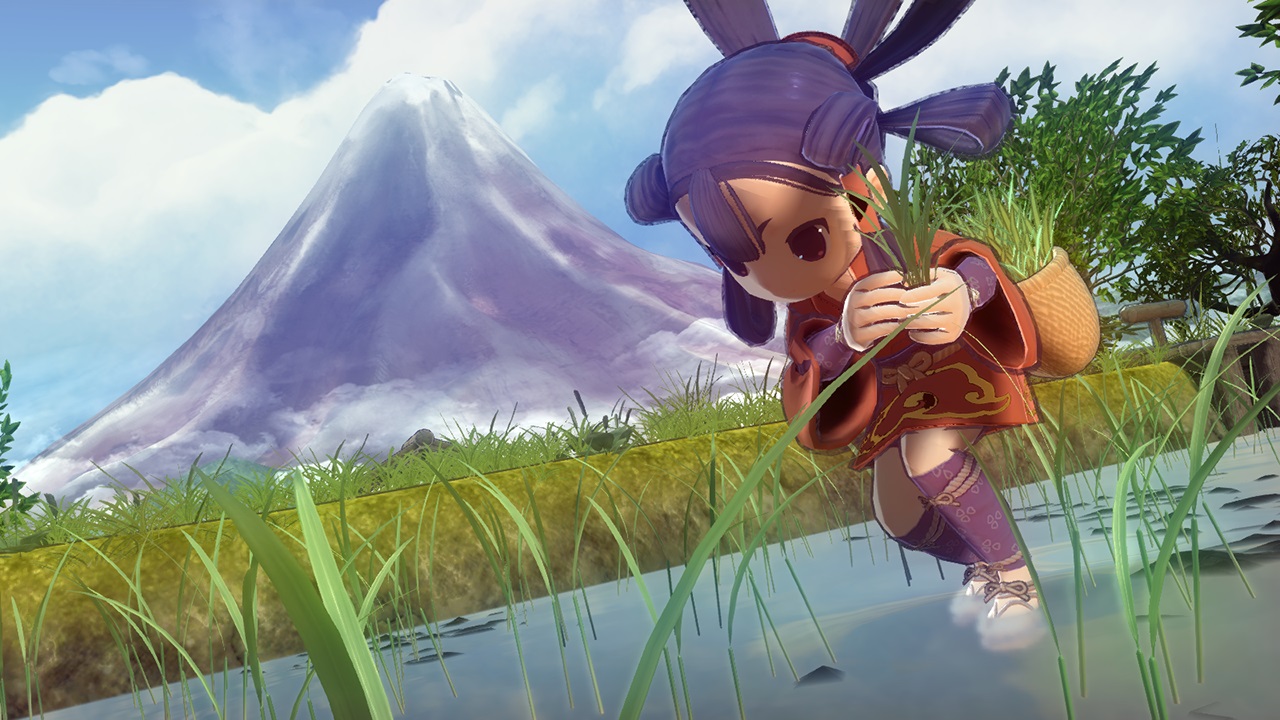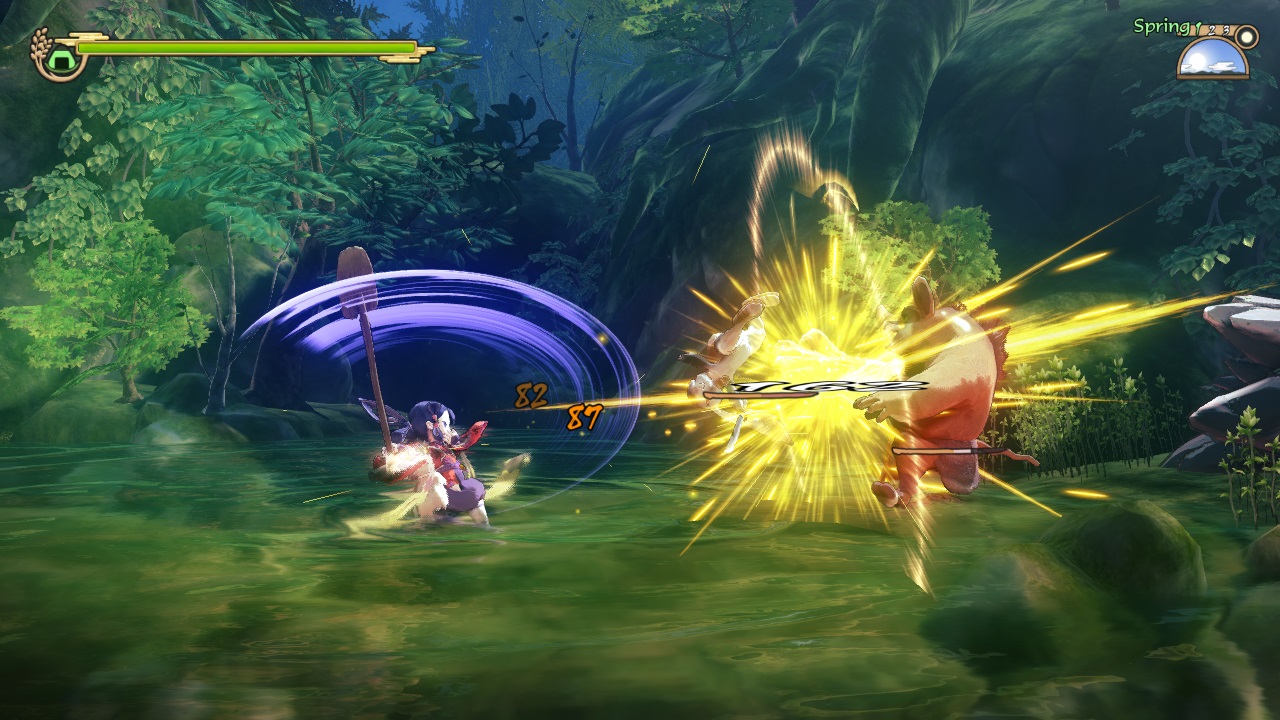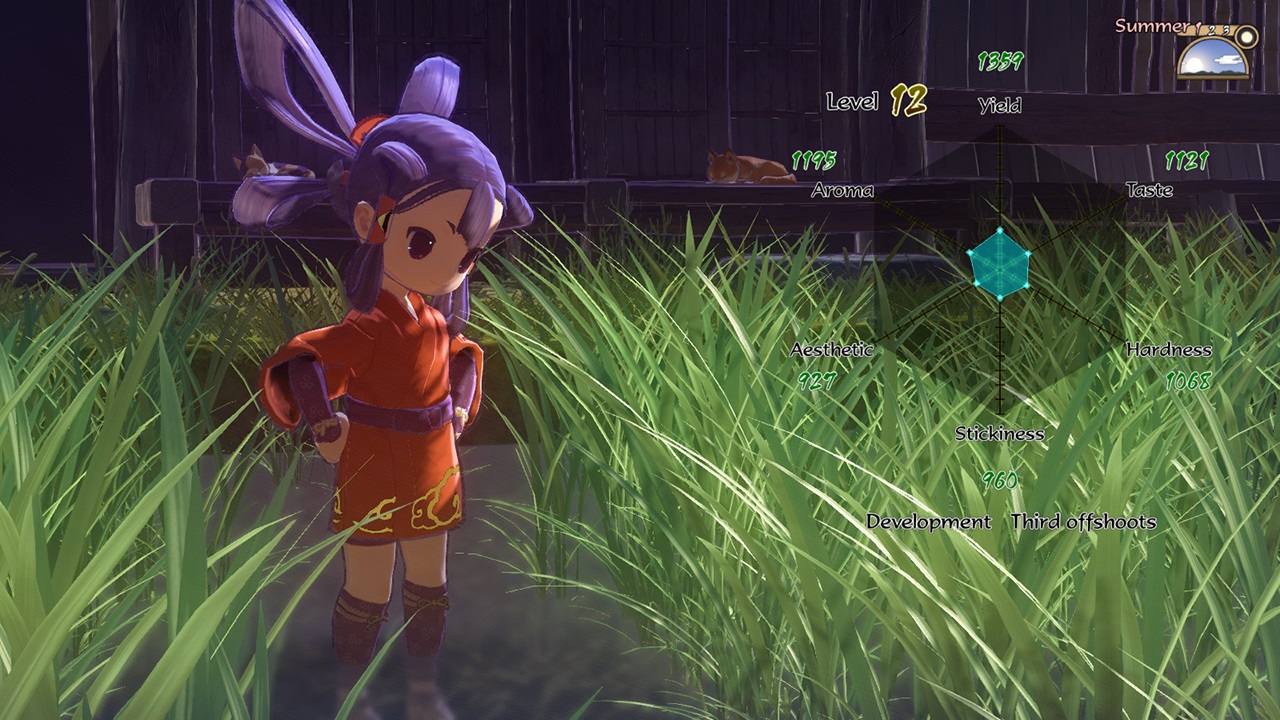[Review] Sakuna: Of Rice and Ruin
System: Switch
Release date: November 10, 2020
Developer: Edelweiss
Publisher: XSEED / Marvelous
Farming simulation has had an interesting history ever since Harvest Moon popularized it way back in the 90s. I was always fascinated by the idea of simulators in general, but it wasn’t until recent years when I started to really feel like the genre started to accommodate more types of players and creativity really started to help drive the genre forward. Games like Dragon Quest Builders, Summer in Mara, and Rune Factory give players much more to do than waking up at 6 AM to check the mail and grab some fresh fish and carrots. These kinds of titled helped players like myself ease into the gameplay while also offering a sense of adventure alongside the more serene moments of farming and relaxation. Sakuna: Of Rice and Ruin continues this trend of implementing a new way to play and acquiring the materials you need to build a future in a newfound land. It’s as wholesome as it is adventurous, all while providing an immense amount of fun in a unique experience that delves into the love of rice – one of the world’s biggest commodities – as well as Japanese folklore to further exude a beautiful fantasy setting.
After ruining a perfectly splendid evening celebrating a day of tradition and angering the other gods and goddesses of Yamato, Princess Sakuna gets banished from her home by Lady Kamuhitsuki’s order – the reigning goddess of their realm. She has to work and earn the respect back regardless of her position as a “high-ranking noble”, as she so frequently touts, to humble herself and understand the appreciation and gratitude goddesses must have when being offered gifts, especially rice as a sacred food to be bestowed. Sakuna is tasked, along with her human companions, to go to the Hinoe Island, also known as the Isle of Demons, where it was once known to prosper between the planes of heaven and earth before becoming infested with demons. It’s on this journey she makes way to revisit an old home and start a new life (for the foreseeable future) with the humans in tow to raise her own rice and gather the necessary ingredients needed to cleanse the Isle of Demons and bring it back to its former glory.
Since Sakuna is spoiled, getting her to do the tasks at first is a chore in itself, but it’s a clever way to begin the game as players familiarizes themselves with the mechanics and how the farming portion of the game works before having to go out and actually retrieve supplies. You’re given a small little patch at first to grow rice and get yourself acquainted with planting and the typical farming approach, but things work a little differently than they do in a usual simulation experience. Even with games that allow you to free roam, placing items down in soil typically is done in a gridlocked manner, but in Sakuna: Of Rice and Ruin, you can move freely around the soil after tilling it, which takes more time than it should. The lack of symmetry for someone like me who likes to keep things organized frustrated me to no end, and the slow process of planting the rice itself and constantly getting penalized if it’s too close or too far from one another did feel like a bit of a chore.
After a few in-game days, you’re able to pull the rice before going preparing for shaving and hulling. This is a repeated process that grows and expands as Sakuna slowly begins to come to terms with the process and the player gets comfortable with the sequence of tasks. While this could easily get cumbersome and repetitive on its own, the adventure portions of Sakuna’s journey as well as the various quests at hand from other humans and characters you meet along the way offer a nice balance. You can do one or the other as much as you please, though there will be a point where you’re forced to farm or venture out. That’s because if you neglect one side for too long, you’ll eventually notice that you’re not making much of any progress. The game doesn’t necessarily force you, but it’s a natural observation if you stick with one portion for too long, and it’s immensely fun to gather resources and drop them off back at home as you expand your fields.
You do gain abilities as you level up through your farming that can give you more “passives” – if you will – while farming, and eventually you can see a grid-like flooring down on the soil. However, placement is still entirely free-form, so it’s mainly a guide, though the placing of them can still be problematic. As you go through Sakuna: Of Rice and Ruin, you’ll have to deal with the seasons as well and all of their weather patterns to best prepare for a time without crops or severe weather that can harm the yield and cause trouble down the line. This causes for a lack of food as well and can make those around you very unhappy, and the food is also necessary when you want to have a successful day of hunting and scavenging as you’ll get stat boosts and be able to get more perks in and out of combat.
Speaking of combat, the bulk of your time spent outdoors when exploring new areas will be taking out the demon infestations from place to place by utilizing the talents at your disposal and making Hinoe Island a prosperous place once again, and thankfully this part is mostly fluid. You’ll have a few moves you can attach to any button prompts and switch them out however you’d like, and even better is the ability to expand each with certain passives and buffs that you can equip and reequip on the fly. These powers added to your equipment can range anywhere from a simple buff of adding an X value more to your overall attack for a weapon, to providing more of a chance of monsters dropping rarer items or more of a particular item. They come naturally as you level up and use more weapons and certain equipment as a whole, including masks and headgear that you can attach to Sakuna to customize her both visually and mechanically.
Proficiency levels get higher as you use your skills with each weapon, and these will of course grow and enhance your overall power as you make use of them. Certain moves feel better in certain places, like a Frontal Smash attack moving forward or backwards would make most sense to me as a Forward+A input rather than a Down+A or a simple button tap of A. The fighting skills alongside your raiment skills which utilize your clothing (like a bow or scarf) for attacks also play a part in making sure your chances of survival in combat are as high as they are swift, making for easy dodges, pulls, grapples, and more. At first combat feels a bit sluggish, but as you progress more and customize everything to your liking, Sakuna: Of Rice and Ruin almost begins to feel like a side-scrolling hack-and-slash powerhouse with a stunning aesthetic, though I would notice certain delays between moves would cause combos to not be as seamless as I would have liked.
Performance-wise, Sakuna: Of Rice and Ruin is mostly stable on Switch, and even when things would get crazy in combat (because there can be a lot of effects going on at times with hordes of enemies trying to take out your resident goddess), it still handled its own. My biggest worry, however, is that you would sort of see this sort of double-buffer v-sync where it would either be running at 60 or all of a sudden be 30 frames per second. While I’d rather have one or the other instead of a varied frame rate that would ultimately make things feel sluggish and inconsistent, it would be really jarring when this would happen and, in the fields in particular, would cause for missed inputs or an already slow farming process to feel as if it’s dragging on more. Things can even become overwhelming while exploring, but thankfully it was never enough to really be detrimental to the experience. Sakuna: Of Rice and Ruin is a beautiful game while you’re on the fields working with good lighting and sunsets complementing the outdoors and vivid nature around you, but I only wish this same sort of attention was done inside of dungeons as well. It’s not that the dungeons necessarily feel bland, but you tend to lose excitement over time in them when it’s the same sort of generic formula between each that makes it feel uninspired aesthetically and through gameplay.
Sakuna: Of Rice and Ruin remains a unique take on the genre with added flavor that really makes it stick out from all the other cross-genre farming simulation games. While I wish there were more quality of life improvements like being able to choose how to plant certain things and ease of access to certain areas as well as the ability to tweak other aspects to your liking to make it a truly tailored experience, the game still provides a ton of fun and is a heartwarming experience thanks to its quirky characters, beautiful setting, and a story of growth both on and off the fields through labor and maturity. Even if you’re going in for just the side-scrolling portions or the farming portions of the game, you’re bound to have a great time and you’ll be eased into the other half of the game you’re less interested in as they both complement each other in a really great and clever way. The game never truly feels like it gets too overwhelming or has an obnoxious amount of tasks to get through. Progression feels natural which I think is important for a game like this, and eventually after playing enough of it you’ll be able to freely farm and explore as you sit fit.
The Verdict
Sakuna: Of Rice and Ruin is, overall, a wholesome and clever new way to enjoy a nice combination of farming simulation and side-scrolling action-adventure gameplay. Neither one of these aspects feels like they last longer than they should as the levels are mostly bite-sized for the initial run and any necessary requirements needed to unlock the next area never felt too grindy or tedious. The levels can, however, become deeper as you choose to revisit them further and function in an almost Metroidvania-esque fashion through the upgrades you unlock later down the line. Additionally, Sakuna constantly felt rewarding no matter what I was doing on and off the farm. The game exudes charm and the characters are all likeable as our resident rice-growing goddess comes to terms with her humanly tasks and newfound friends. You’ll see how she grows and appreciates all the hard work her and her friends put into revitalizing a demon infested part of land, providing a prosperous future where the versatility of rice can build a brand new world. Now I’m in the mood for rice.
Review copy provided by the publisher for the purposes of this review.




